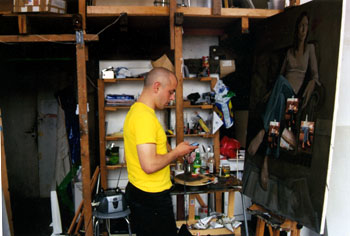Some words about my work.
Benni D'Arcy Esposito
In the 1940's, the newly discovered Vermeers were acclaimed by experts as his greatest work and hung in the finest museums of northern Europe, even being sought after by the greatest art collector of the day - Herman Goering.
But a few years later, after being exposed as fakes, the paintings were taken down by embarrassed curators and critics - the establishment was humiliated, reputations were ruined, fortunes were lost. The only things that didn't change were the paintings themselves. Revered then reviled - they stayed exactly as they were - wood, canvas and paint.
In my figurative paintings, the compositions tend to be borrowed from, or at least echo the compositions of paintings from the past - generally the 19th century. Like actors playing recognizable roles, certain aspects of the figures seem familiar. This is amateur dramatics though, and there are cracks in the make-up. The settings, whilst grand-looking, seem modern and inconsequential upon examination. Despite the inherent melodrama of the compositions, the scenes are fairly ordinary and domestic. Layers unfold, and the picture is reinterpreted as the narrative clues emerge.
The Victorian era, with the tragic Pre-Raphaelites and the last great Olympian painters was an age of idealism in art. It's a type of idealism that's long dead in these cynical times, but it can be re-examined and interpreted through the relics it left behind.
For me, painting is an empirical form of investigation. When making a painting I adopt certain aspects of the classical style, from the way I build the stretcher to the way I apply the glazes. Of course, whilst my actions and the very work itself echo's the past, it can only ever be a distant relative. That relationship between the old and the new can be described in terms of the gap of time and history between them. I want my paintings therefore, to be romantic and seductive, but at the same time resonate a more cynical message about the illusion of romance and the historically transient nature of ideals.
In modern figurative painting there are often questions about originality and purpose. Is the genre cyclical and repetitive? Some people do imitate, but what is produced can only ever be a reflection of their intentions.
I freely appropriate many technical and narrative elements of classical painting - not to mimic or emulate, but to use as a template to understand how things were and how things are.
In appropriating the past, I am using history as a comparative tool for learning about contemporary life - a bit like Van Meegeren did, but I hope with a little more honesty.
Benni Esposito, 2001
